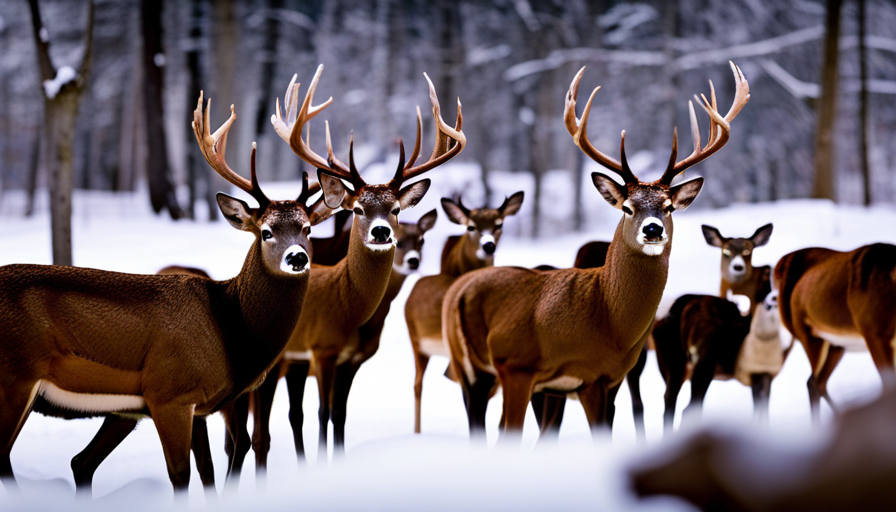Some may think that deer are helpless creatures in the face of winter’s harsh conditions. However, these graceful animals have evolved unique adaptations and behaviors to survive the cold and stay cozy.
From growing a thicker, longer, and darker winter coat to fattening up on high-energy food, deer are masters at staying warm and comfortable during the winter months.
In this article, we will explore six of the most interesting adaptations and behaviors of deer in winter, shedding light on how these animals are able to thrive in the face of adversity.
Despite their innate ability to survive in winter, deer face numerous challenges during this season. With temperatures dropping and food sources becoming scarce, these creatures must rely on their wits and natural instincts to survive.
However, through a combination of physiological and behavioral adaptations, deer have become experts at maintaining their body heat, navigating icy terrain, and finding food in even the most difficult conditions.
By examining the fascinating adaptations of deer in winter, we can gain a deeper appreciation for these remarkable creatures and the ways in which they have adapted to their environment over time.
Winter Coat and Hair
The adaptations of deer in winter include a thicker, longer, and darker winter coat with hollow hairs that absorb and hold heat, acting as an insulator. The winter coat of deer is designed to trap heat and keep them warm in cold temperatures. The hairs on the winter coat are hollow, which allows them to absorb and hold heat, acting as an insulator.
This adaptation is essential for deer to survive in winter, as it helps them maintain their body temperature and conserve energy. The winter coat of deer is also thicker and longer than their summer coat. This adaptation provides additional insulation and protection from the cold.
The darker color of the winter coat helps absorb more heat from the sun, which is essential for deer to stay warm. Overall, the winter coat of deer is a remarkable adaptation that allows them to survive in harsh winter conditions.
Regulation of Body Heat
Regulating thermal balance is a crucial strategy for survival in frigid climates, and deer have evolved several mechanisms to help them maintain a comfortable body temperature. One of these is the ability to regulate heat levels in certain parts of their bodies. By selectively constricting or dilating blood vessels, deer can redirect blood flow to areas that need more warmth, such as their extremities, or to areas that need to expel heat, such as their ears. This process is known as thermoregulation and allows deer to adapt to changing temperature conditions.
Another important adaptation is the layer of fat that acts as both an insulator and an energy reserve when food is scarce. This layer of fat helps to trap heat close to the body and protects against the cold. Additionally, deer can create most of their heat internally through metabolic processes, which is why they are classified as endothermic animals.
Finally, deer are known to look fluffier in winter due to their thicker coats and darker hairs, which provide extra warmth. Together, these adaptations allow deer to thrive in cold winter conditions, even when food is scarce and temperatures drop to sub-zero levels.
Survival Strategies
Survival in cold winter environments involves the implementation of various strategies to maintain thermal balance, conserve energy, and protect against predators. Deer have adapted to these challenges by utilizing several survival strategies.
For instance, deer often stay in groups to spot predators easily and huddle together for warmth. This helps them conserve energy and maintain thermal balance by sharing body heat. Additionally, they rely on shelters for rest and to wait out snowstorms. These shelters can be natural, such as thickets and hollow trees, or they can be man-made, such as barns or sheds. By seeking shelter, deer can conserve energy and avoid exposure to harsh winter elements.
Another survival strategy employed by deer is the ability to survive on some dead leaves, twigs, and bark. While not ideal, this allows them to conserve energy by utilizing alternative food sources when their primary food sources are scarce. Additionally, deer tend to look fluffier in winter due to their thicker coat and darker hairs for extra warmth. This adaptation helps them maintain thermal balance by trapping heat close to their bodies.
Finally, deer are endothermic and can create most of their heat internally. Their fat stores are filled with extra energy for dire situations when food is limited. By adapting to these harsh winter environments, deer have developed several survival strategies that allow them to maintain thermal balance, conserve energy, and avoid predators.

